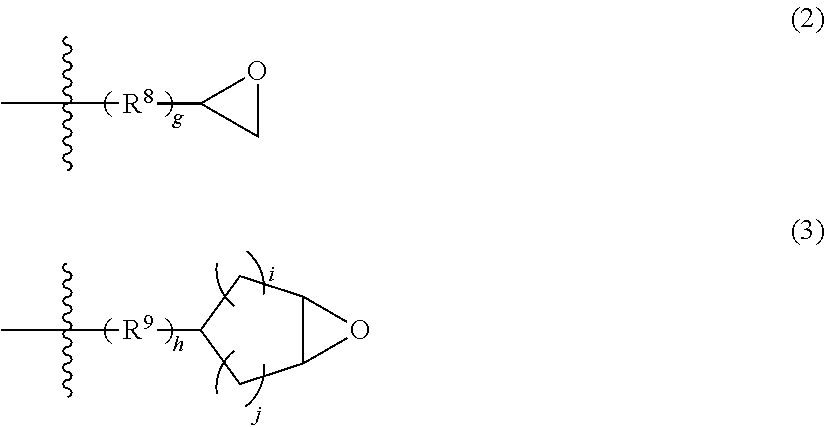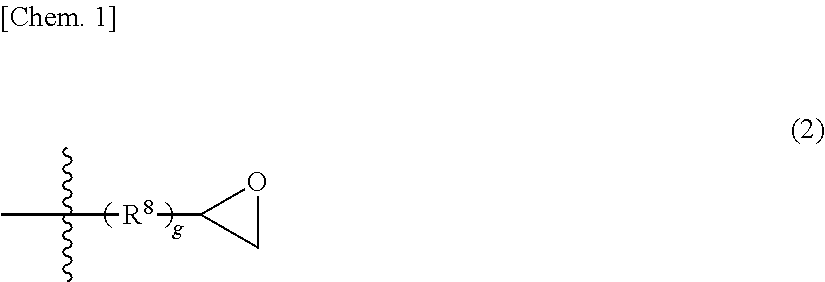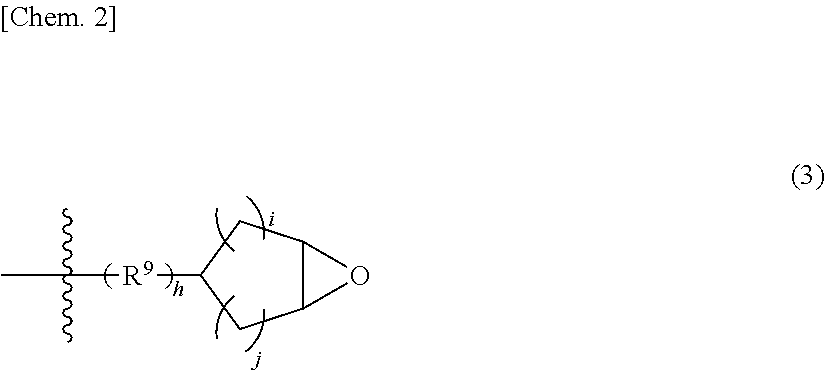Polyorganosiloxane with epoxy group, curable resin composition containing polyorganosiloxane with epoxy group, and cured product thereof
a polyorganosiloxane and epoxy group technology, applied in the field of polyorganosiloxane with epoxy group, can solve the problems of poor compatibility of alicyclic epoxy resin with photopolymerization initiator, insufficient surface properties, adhesiveness and impact resistance of alicyclic epoxy resin, etc., and achieve high compatibility, low viscosity, and high curing rate
- Summary
- Abstract
- Description
- Claims
- Application Information
AI Technical Summary
Benefits of technology
Problems solved by technology
Method used
Image
Examples
synthesis example 1
ganosiloxane with Epoxy Group 1
[0193]A mixture of 625 parts by weight of 1,1,3,3-tetramethyldisiloxane, 504 parts by weight of hexamethyldisiloxane, and 422 parts by weight of methyl silicate MS51 as raw materials of a polyorganosiloxane with an epoxy group, 987 parts by weight of tetrahydrofuran as a solvent, and a mixture as a catalyst and water composed of 115 parts by weight of 1 N hydrochloric acid and 115 parts by weight of methanol was subjected to hydrolysis and condensation at 30° C. 938 parts by weight of heptane was added to the mixture, and the hydrochloric acid was removed by washing with demineralized water. The solvent was then evaporated with a rotary evaporator at 76° C. under a reduced pressure of 15 torr until the evaporation of the solvent was not visually observed. The product was then heated at 120° C. under a reduced pressure of 0.15 torr for 2 hours. Thus, 727 parts by weight of a polyorganosiloxane precursor with an epoxy group 1 was prepared.
[0194]75 parts ...
synthesis example 2
ganosiloxane with Epoxy Group 2
[0196]After 75 parts by weight of a polyorganosiloxane precursor with an epoxy group 1 prepared in the same manner as in Synthesis Example 1 was dissolved in 132 parts by weight of heptane, 1.4 parts by weight of a catalyst-containing solution containing HS432 dissolved in heptane at a platinum concentration of 0.2% by weight was added and stirred. After heating to 75° C., a mixture of 63 parts by weight of 1,2-epoxy-4-vinylcyclohexane and 58 parts by weight of allyl glycidyl ether was added dropwise over 1 hour and was heated at 75° C. for another 10 hours. After cooling to near room temperature, 15 parts by weight of activated carbon was added, and the mixture was stirred for 2 hours and was then filtered. The solvent was then evaporated from the solution with a rotary evaporator at 60° C. under a reduced pressure of 15 torr until the evaporation of the solvent was not visually observed. The product was then heated at 85° C. under a reduced pressure ...
synthesis example 3
ganosiloxane with Epoxy Group 3
[0198]A mixture of 625 parts by weight of 1,1,3,3-tetramethyldisiloxane, 504 parts by weight of hexamethyldisiloxane, and 422 parts by weight of methyl silicate MS51 as raw materials of a polyorganosiloxane with an epoxy group, 987 parts by weight of tetrahydrofuran as a solvent, and 115 parts by weight of 1 N hydrochloric acid and 115 parts by weight of methanol as a catalyst and water was subjected to hydrolysis and condensation at 30° C. 938 parts by weight of heptane was added to the mixture, and the hydrochloric acid was removed by washing with demineralized water. The solvent was then evaporated with a rotary evaporator at 76° C. under a reduced pressure of 15 torr until the evaporation of the solvent was not visually observed. The product was then heated at 120° C. under a reduced pressure of 0.15 torr for 2 hours. Thus, 768 parts by weight of a polyorganosiloxane precursor with an epoxy group 3 was prepared.
[0199]200 parts by weight of the poly...
PUM
| Property | Measurement | Unit |
|---|---|---|
| pressure | aaaaa | aaaaa |
| mole ratio | aaaaa | aaaaa |
| weight loss rate | aaaaa | aaaaa |
Abstract
Description
Claims
Application Information
 Login to View More
Login to View More - R&D
- Intellectual Property
- Life Sciences
- Materials
- Tech Scout
- Unparalleled Data Quality
- Higher Quality Content
- 60% Fewer Hallucinations
Browse by: Latest US Patents, China's latest patents, Technical Efficacy Thesaurus, Application Domain, Technology Topic, Popular Technical Reports.
© 2025 PatSnap. All rights reserved.Legal|Privacy policy|Modern Slavery Act Transparency Statement|Sitemap|About US| Contact US: help@patsnap.com



